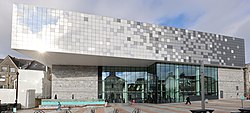The Box, Plymouth
 The Box | |
Location within Devon and England | |
| Established | 1910 |
|---|---|
| Location | Plymouth, Devon, England |
| Coordinates | 50°22′28″N 4°08′15″W / 50.37445°N 4.13762°W |
| Type | Art museum and history museum |
| Website | Official website |
The Box is a museum, gallery and archive in Plymouth, Devon, England, opened in 2020 housing a collection of about 2 million items.[1][2] The core of the building was previously Plymouth City Museum and Art Gallery which closed in 2016. The building was created in 1907–1910 by Thornely and Rooke in Edwardian Baroque style.[3] and was combined with the former Central Library building and St Luke's Church on Tavistock Place into The Box.[4]
Collections
The Plymouth City Museum and Art Gallery's collections were transferred to The Box. They encompass fine and decorative arts, natural history and human history. The natural history collection consists of over 150,000 specimens and an historic natural history library and archive. Many prehistoric artefacts from Dartmoor, important Bronze Age and Iron Age material from Mount Batten and medieval and post-medieval finds from Plymouth are found in the human history collection alongside artifacts from ancient Egypt and other ancient cultures of Europe and the Middle East.
The art collections include 750 easel paintings, over 3,000 watercolours and drawings, at least 5,000 prints and a sizeable collection of sculptures. A large proportion of the art was donated to the people of Plymouth in 1852 by William Cotton (1794–1863) and is known as the Cottonian Collection. It had been put together principally by the collector Charles Rogers (1711–1784), and includes works by Sir Joshua Reynolds who was born locally.[5]
The collections also include work by artists of the 19th-century Newlyn School, the influential 20th-century St. Ives group of painters, and the Camden Town Group. Other artists represented are Edgar Degas, Edward Burne-Jones, Paul Nash, Stanley Spencer, John William Waterhouse, Claude Lorrain, Terry Frost, J. M. W. Turner, John Brett, John Everett Millais, Ambrose Bowden Johns, Benjamin Robert Haydon, James Northcote and Samuel Prout. The latter four painters were born locally.
Funding
The Museum and Art Gallery was owned and operated by Plymouth City Council. It also received operational funding from Arts Council England through its Major Partner Museums scheme.
Additional grants for specific projects, acquisitions and conservation duties came from funding bodies such as the Heritage Lottery Fund, The Art Fund, the Wolfson Foundation and the V&A Purchase Grant Fund.
Redevelopments

In early 2009, four new galleries showcasing the Museum's world cultures, Ancient Egypt, archaeology and local/maritime history collections were opened as part of a refurbishment project.[6] The renovated ground floor galleries were formally opened by HRH Prince Philip, Duke of Edinburgh on 25 May 2009.[7] He was Patron of the Friends of Plymouth City Museums & Gallery, which was founded in 1951, at the time.
Plymouth City Museum and Art Gallery closed its building at the start of September 2016 for major redevelopment. It re-opened in 2020 as The Box, Plymouth which encompassed the Museum and Art Gallery, former Central Library and St Luke's Church buildings with a major new extension designed by Atkins.[2] It brought collections from the museum, Plymouth and West Devon Record Office, South West Film and Television Archive (SWFTA), South West Image Bank and the Local Studies and Reference collection from the Central Library onto one site.
The former SWFTA archive has been merged with other film collections now held by The Box as part of their Moving Image collection. The Box holds all rights to the Westward Television and TSW archives, and is in control of any private or commercial licensing. It has been criticised for making this process needlessly bureaucratic in nature [8]
There are permanent galleries, research facilities and a series of spaces for changing exhibitions and artistic commissions. The multi-million pound project includes major funding support from the Heritage Lottery Fund, Plymouth City Council and Arts Council England.[9][10] As part of the redevelopment fourteen newly restored 19th-century figureheads were placed in the museum's atrium.[11]
References
- ^ Morris, Steven (22 September 2020). "New Plymouth museum and art gallery opens with Mayflower and mammoths". The Guardian. Retrieved 30 November 2020.
- ^ a b Wainwright, Oliver (22 September 2020). "'Like a storage shed blown in by a gale' – Plymouth's new £46m Box gallery". The Guardian. Retrieved 30 November 2020.
- ^ Pevsner, Nikolaus; Cherry, Bridget (1989). The Buildings of England: Devon. London: Penguin. p. 657. ISBN 0-14-071050-7.
- ^ "The Box". Retrieved 23 October 2022.
- ^ "The Cottonian Collection". Plymouth City Museum & Art Gallery. Archived from the original on 20 August 2008. Retrieved 11 November 2008.
- ^ "HRH Duke of Edinburgh to visit City Museum and Art Gallery". Plymouth City Council. Archived from the original on 9 June 2011. Retrieved 29 June 2009.
- ^ "The Duke of Edinburgh, Patron, Friends of Plymouth City Museums and Art Gallery, this afternoon visited the newly refurbished Plymouth City Museum and Art Gallery, Drake Circus." Court Circular for 25 May 2009.
- ^ Philip, Renfrew. "All Boxed In". Transdiffusion.
- ^ "The story so far..." Plymouth City Council. June 2016. Retrieved 1 July 2016.
- ^ "Spectacular plans for the History Centre unanimously approved". Plymouth City Council. 10 June 2016. Retrieved 1 July 2016.
- ^ Wu, Katherine J (12 March 2022). "Rescued From Rot, 19th-Century Naval Figureheads to Feature in New Exhibit". Smithsonian magazine. Retrieved 26 October 2022.

